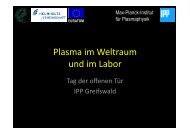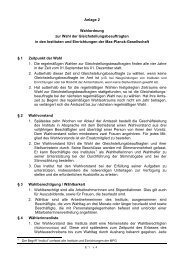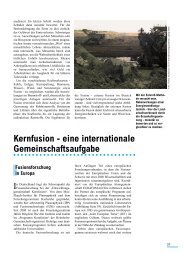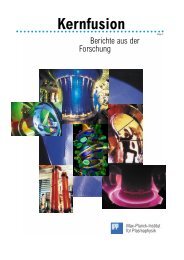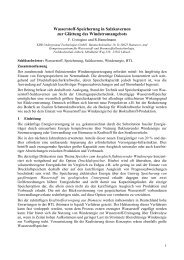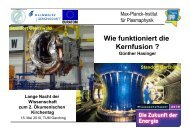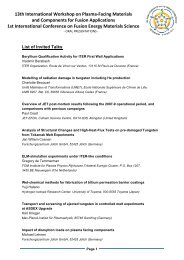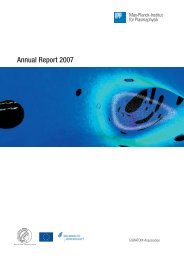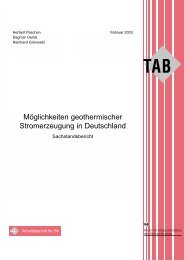Wendelstein 7-X and fusion - Max-Planck-Institut für Plasmaphysik
Wendelstein 7-X and fusion - Max-Planck-Institut für Plasmaphysik
Wendelstein 7-X and fusion - Max-Planck-Institut für Plasmaphysik
Create successful ePaper yourself
Turn your PDF publications into a flip-book with our unique Google optimized e-Paper software.
4<br />
Nuclear <strong>fusion</strong> reaction scheme<br />
Proton<br />
Neutron<br />
Deuterium<br />
Tritium<br />
<strong>Wendelstein</strong> 7-X<br />
The <strong>Max</strong> <strong>Planck</strong> <strong>Institut</strong>e for Plasma Physics (IPP) conducts research into the theoretical<br />
<strong>and</strong> physical principles underlying <strong>fusion</strong> power plants. Worldwide, it is the only institute<br />
that investigates both important types of <strong>fusion</strong> device: the tokamak <strong>and</strong> the stellarator.<br />
The ASDEX Upgrade tokamak is in operation in Garching <strong>and</strong> the <strong>Wendelstein</strong> 7-X stellarator<br />
is under construction in Greifswald.<br />
n<br />
Energy<br />
Helium<br />
Hydrogen nuclei fuse in the sun <strong>and</strong> stars under enormous<br />
gravitational pressure. A <strong>fusion</strong> power plant on Earth, however,<br />
must operate on another principle. Under terrestrial conditions<br />
it is the two types of hydrogen, deuterium <strong>and</strong> tritium,<br />
which react most easily. They form a helium nucleus; a neutron<br />
is also released <strong>and</strong> huge amounts of usable energy are<br />
generated. In a power plant, one gram of fuel can generate<br />
90,000 kilowatt-hours of energy. This corresponds to the heat<br />
of combustion of 11 tons of coal.<br />
The optimized <strong>Wendelstein</strong> 7-X device will demonstrate the suitability of the stellarator<br />
device as a power plant. Discharges of up to 30 minutes will demonstrate its essential<br />
property, namely, that of continuous operation.<br />
A key part of the experiment is the coil system, which consists of 50 non-planar <strong>and</strong> 20<br />
planar superconducting magnetic coils. They create magnetic fields, which confine the<br />
hydrogen plasma at temperatures up to 100 million degrees, so that it can be investigated<br />
with various techniques.<br />
In the magnetic coils a superconducting niobium-titanium conductor is used rather than<br />
a normally conducting copper material. During the experiment, liquid helium will flow<br />
through the coils to cool them down to temperatures of approximately -270 degrees<br />
Celsius, close to absolute zero.<br />
Due to this low operating temperature, the coils have been installed in a cryostat that is<br />
made up of a plasma vessel <strong>and</strong> an outer vessel. The vacuum generated between the<br />
two vessels insulates the coils from ambient heat. The plasma can be investigated <strong>and</strong><br />
heated using the 254 ports.<br />
Three different methods are used for heating the plasma: microwave heating with a<br />
power of 10 megawatts, radio wave heating with 4 megawatts <strong>and</strong> neutral beam injection<br />
heating with 20 megawatts.<br />
Companies from all over Europe have worked closely with the <strong>Max</strong> <strong>Planck</strong> <strong>Institut</strong>e for<br />
Plasma Physics in developing <strong>and</strong> manufacturing the <strong>Wendelstein</strong> 7-X device. This process<br />
has given rise to many dem<strong>and</strong>ing challenges <strong>and</strong> provided the participating companies<br />
with valuable technological expertise. The following pages will describe a few of<br />
these achievements.<br />
The five <strong>Wendelstein</strong> 7-X modules rest<br />
on the foundation of the machine.




